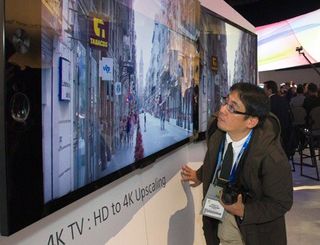4K, 8K and Wall Space

PHILADELPHIA — Ultra HD television took center stage at last week’s annual Tech It Out here, an all-day program put on by the Greater Philadelphia chapter of Women in Cable Telecommunications.
“It’s a very important technology,” Comcast chief technology officer Tony Werner, who opened the afternoon portion of the program, said. “Video fidelity is something we continually go after.”
Plus, noted Paulette Pantoja, CEO and founder of BluFocus, which does quality and performance testing on in-home electronics like Blu-ray Disc players, we’ll likely see Ultra HD titles on packaged media as soon as this Christmas season.
“That includes the player and the discs,” she said. (Up until now, one of the many hitches in the supply chain for Ultra HD was that it’s just too big for standard Blu-ray.)
Also this holiday buying season, Pantoja noted, Ultra HD sets will hit the market that include HDMI 2.0 — prior iterations of the connector were, again, not big enough, capacity-wise, to move Ultra HD content.
Right now, about 7% of homes in the U.S. and Canada own Ultra HD sets, according to fresh data from the Arris Consumer Entertainment Index, which was released last week; globally, China is the leader at 24%.
What still needs to catch up, of course, is the content. Consider a network like ESPN, which does around 650 remote events a year, using 70-plus production trucks. All of it requires an overhaul, in order to capture content in Ultra HD.
Broadcasting & Cable Newsletter
The smarter way to stay on top of broadcasting and cable industry. Sign up below
So far, and much like the early days of HD, most of the slim-but-growing amount of Ultra HD content is coming from the movie studios.
ENTER 8K TELEVISION
And right on the heels of Ultra HD is the next iteration in TV screens — 8K, where the “8K” means 8,000 lines of resolution. Earlier this month, IHS projected that 2,700 8K sets will ship this year, growing to just under 1 million by the time of the 2020 Summer Olympic Games in Tokyo.
Set makers said that 8K televisions are likely to start out in precision-oriented applications used in the medical and distance learning industries, more so than in homes.
But still, weight-wise, 8K is a whale. Where Ultra HD requires around 25 to 30 Megabits per second, and “regular” HD about 5 Mbps, 8K needs around 60 Mbps. That’s huger than huge — as are the screens themselves.
Consider this: A common size for an Ultra HD television set is 65 inches, measured on the diagonal. That’s 5 feet, 4 inches — which is also the average height of a human female.
8K sets will push the wall space requirements even more. At the 2015 International CES, the big set manufacturers rolled out 110-inch 8K displays (over nine feet); most expect the average size of an 8K screen to be about 85 inches (seven feet).
A little over two years ago, this column ran under a headline of “You Have Eight Years to Move the Bookcase.” Timing errors aside, and given that we now live in perpetually accelerating times, here’s a revised observation: You have six months to move the bookcase!
And remember to make sure that the wall behind it is sturdy enough to hold your fancy new home-theater screen.
